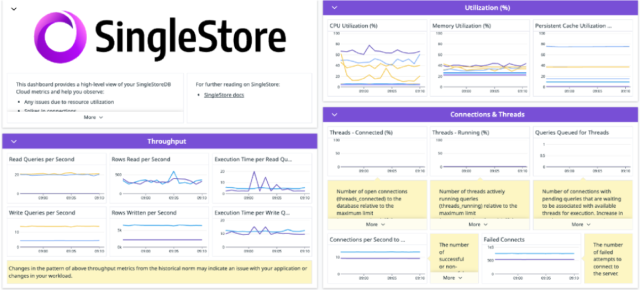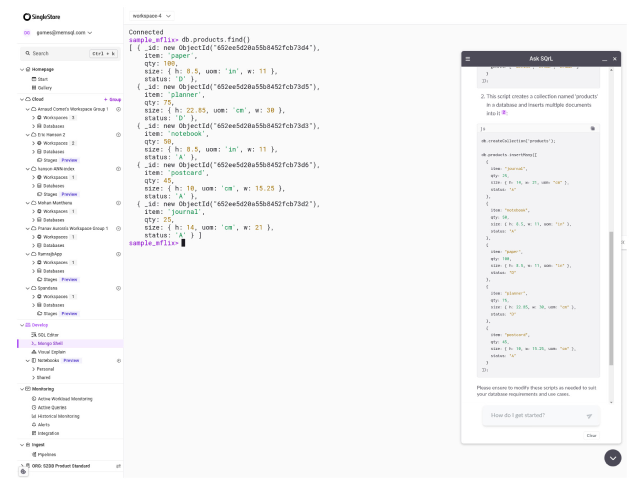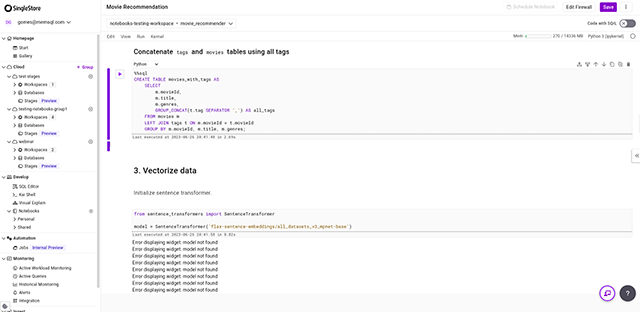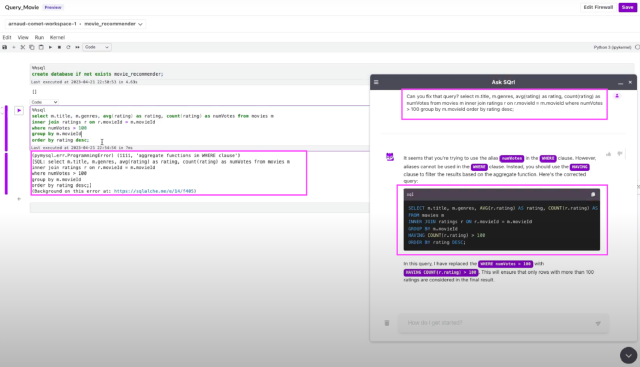
SingleStore (née MemSQL) started as a self-managed distributed database product around a decade ago. We announced our fully managed cloud offering in September 2019, so it's been around four years since we've begun operating as a cloud-first company and selling a fully managed database as a service. And 2023 was another incredible year in this journey. In this blog post, we'll look at what we shipped last year, and how our cloud service matured during that time.
This blog post is more focused on the platform for Singlestore Helios, and core database engine updates will be better described in other incoming blog posts — stay tuned! If you're interested in more granularity, we keep a live log of everything we ship in our docs.
Monitoring and alerting
At the close of 2022, we announced historical monitoring as a core part of our managed service offering. During 2023, we expanded this offering and added an alerting capability as well. This way, our customers now get notifications in case their CPU utilization goes above a certain threshold. Of course, there's many more alerts available and we'll continue to expand these.
Our monitoring dashboards, which are built with Grafana, have also been improved. These are actually powered by SingleStoreDB itself, so they're very fast. Nevertheless, we've made them easier to use — specifically for tracking individual workspace metrics.
But what if customers want to use Datadog to monitor SingleStore? Well, that's now possible too! In August, we announced our integration with Datadog so our customers can observe their SingleStore deployments with Datadog.

SingleStore Kai™
In May of this year, we announced Singlestore Kai™, an API that allows customers to accelerate queries on their MongoDB data with no changes to their data or application code.
With Kai, we've become a multi-model database product that can, in essence, "speak" multiple languages! And while it is currently in preview, we're continuously improving it and will make it generally available in 2024.

Together with Kai, we launched an interactive shell that our users can use to run MongoDB queries on their SingleStore instances via our Cloud Portal UI. Learn more about it in this announcement blog post.

Developer Experience: Notebooks, Stage, SQrL and more
DevEx has been a very hot topic at SingleStore in the last year! We've made a lot of improvements in this area, the most notable being Notebooks, which we announced in April. Our users can now write custom Python code that securely connects to their database, and collaborate on interactive documents — all in our Portal UI.

Our customers have been absolutely delighted with Notebooks, and we're investing heavily in them as a "platform within a platform." In fact, Notebooks already drive a lot of the engaging experiences that SingleStore can provide, such as building lightweight dashboards, doing data prep, clean up and some ML flows. However, we'll take this to the next level with automation and more soon.
We've also launched singlestore.com/spaces, which is a public gallery of notebooks that users can use to "test drive" SingleStoreDB.
Together with all this, I want to mention the Stage Storage Service — which is a "mini Google Drive" for your database. We announced it in late June, and we're working on stabilizing and improving it before we give it our "generally available" seal of approval. However, it's already being used to easily store and load CSV and other files into SingleStore databases. Learn more about Stage in the official docs.
And then there's SQrL, our beloved chatbot which helps developers use SingleStore. We've launched it across our website, cloud portal and even with the Notebooks UI. This makes it much easier for customers to unblock themselves with writing SQL, or even Python code to interact with SingleStoreDB.

To encourage more developers to build apps with SingleStore, we've created a Vercel integration for Singlestore Helios. We launched it in October, and we're looking forward to seeing what kind of apps people will build with it.
(Oh, and one more thing, even though it's not specific to SingleStore Cloud. This year, we launched a VSCode Extension for SingleStoreDB!)
Faster cloud portal
We've worked very hard this year to make our cloud portal UI much faster. This way, it matches the expectations from our customers, who are used to an extremely high-performance database. We will certainly write more about this in our engineering blog in the near future, but for now you can read about how we optimized our sign up and sign in pages.
Automation
The area where we probably matured the most in this last year has been automation. Our customers are now getting new features more safely and quickly thanks to our implementation of automated rollouts and deployment rings. Inside an organization, customers can even tag their deployments as "Production" or "Non-Production" — and our rollout algorithms will cleverly take this into account. All throughout, we've made updates less impactful and faster overall. Learn more about Cloud Scheduled Updates in our docs.
Another important part of the product that has been automated has been the configuration of inbound Private Links. Before, our customers would have to file support tickets for this, but now the creation of inbound Private Links from AWS VPCs can be done by customers on their own.
Manageability and operations
Our customers have really pushed us to drive up the quality of our clustering operations. In 2023, we launched a few different things that make the product more powerful and easy to use:
- Auto suspend (can be done with a specific schedule, or based on idleness)
- Resize progress. We now display the progress of a scaling operation
- Resize reliability
- We've implemented some guardrails around scaling operations to make them more reliable.
- Additionally, we've made resizes more stable, and our customers are now running many hundreds of these per month.
- Forwarding audit logs. Our Premium and Dedicated customers can now forward their audit logs to tools including Datadog, CloudWatch, Splunk and others.

We've also completed general improvements to the user interfaces around these features, and have continued to make our Management API more comprehensive as well. Learn more about managing SingleStore workspaces in our documentation.
Access control and authentication
One of the biggest missing pieces in terms of security in our cloud portal UI at the start of the year was our lack of role-based access control. This meant that all members of a cloud organization had the same level of privileges when it came to managing their deployments (though not with respect to data access). This year, we launched RBAC for Singlestore Helios!

Still in the security realm of things, we've vastly improved our SSO capabilities and our Identity Platform as a whole. Specifically, our customers can now set up their Single Sign-On (SSO) configuration without our intervention. So, you can see that automation was really a big theme for us this last year, across all parts of our product.
Billing and usage
This year, we focused on modernizing our billing platform. If you've worked on a SaaS product before, you probably know that billing is much more complicated to implement properly than it looks on the surface. So, we spent a lot of time improving our usage collection and invoice generation systems. In addition, we've also taken further steps to reduce fraudulent sign ups.
In early 2024, we'll launch something really special around billing and usage. It will make it much easier for customers to analyze their spend over time, and break down their costs by resource. You can probably guess what it looks like, but I can't show anything for now. All I can say is I've been playing with it for a while, and it'll certainly be very helpful.
Final words
The engineering team has knocked it out of the park with another year of outstanding work — I'm really proud of what we've achieved. All new features aside, the SingleStore Cloud platform has really matured and is now more stable than ever. In fact, a lot of the work we did this year didn't even make it into this blog post, as there's a lot of internal improvements to our infrastructure that aren't directly visible to customers.
Furthermore, our documentation for Singlestore Helios has been massively improved over the last year. Not only did the content receive a lot of improvements, but the UI/UX of the docs platform has also been revamped for a better reading experience. In addition, we now have interactive snippets in our docs so readers can play with SQL functions directly without leaving.
Finally, and this can't be understated, the engineering team behind our Cloud platform has grown from ~30 to around 70 people in the last 12 months. This obviously had an impact on our ability to ship code since we've spent a lot of time onboarding new hires. However, next year, our platform will evolve even more at an even faster rate — don't go anywhere!
Having said that, I'm really looking forward to writing a blog post like this one again in a year! Feel free to reach out directly to me, or through our Forums if you have any questions.

-for-Real-World-Machine-Learning_feature.png?height=187&disable=upscale&auto=webp)




.jpg?width=24&disable=upscale&auto=webp)
_feature.png?height=187&disable=upscale&auto=webp)






